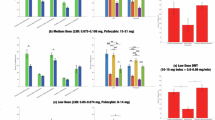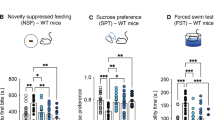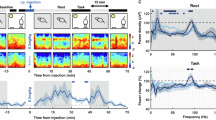Abstract
Binocular rivalry occurs when different images are presented simultaneously to corresponding points within the left and right eyes. Under these conditions, the observer's perception will alternate between the two perceptual alternatives. Motivated by the reported link between the rate of perceptual alternations, symptoms of psychosis and an incidental observation that the rhythmicity of perceptual alternations during binocular rivalry was greatly increased 10 h after the consumption of LSD, this study aimed to investigate the pharmacology underlying binocular rivalry and to explore the connection between the timing of perceptual switching and psychosis. Psilocybin (4-phosphoryloxy-N,N-dimethyltryptamine, PY) was chosen for the study because, like LSD, it is known to act as an agonist at serotonin (5-HT)1A and 5-HT2A receptors and to produce an altered state sometimes marked by psychosis-like symptoms. A total of 12 healthy human volunteers were tested under placebo, low-dose (115 μg/kg) and high-dose (250 μg/kg) PY conditions. In line with predictions, under both low- and high-dose conditions, the results show that at 90 min postadministration (the peak of drug action), rate and rhythmicity of perceptual alternations were significantly reduced from placebo levels. Following the 90 min testing period, the perceptual switch rate successively increased, with some individuals showing increases well beyond pretest levels at the final testing, 360 min postadministration. However, as some subjects had still not returned to pretest levels by this time, the mean phase duration at 360 min was not found to differ significantly from placebo. Reflecting the drug-induced changes in rivalry phase durations, subjects showed clear changes in psychological state as indexed by the 5D-ASC (altered states of consciousness) rating scales. This study suggests the involvement of serotonergic pathways in binocular rivalry and supports the previously proposed role of a brainstem oscillator in perceptual rivalry alternations and symptoms of psychosis.
Similar content being viewed by others
Log in or create a free account to read this content
Gain free access to this article, as well as selected content from this journal and more on nature.com
or
References
Aghajanian GK, Hailgler HJ (1975). Hallucinogenic indoleamines: preferential action upon presynaptic serotonin receptors. Psychopharmacol Commun 1: 619–629.
Aghajanian GK, Marek GJ (1997). Serotonin induces excitatory postsynaptic potentials in apical dendrites of neocortical pyramidal cells. Neuropharmacology 36: 589–599.
Aston-Jones G, Bloom FE (1981). Activity of norepinephrine-containing locus coeruleus neurons in behaving rats anticipates fluctuations in the sleep-waking cycle. J Neurosci 1: 876–886.
Blake R, Logothetis NK (2002). Visual competition. Nat Rev Neurosci 3: 13–21.
Brainard DH (1997). The psychophysics toolbox. Spatial Vision 10: 433–436.
Brown RE, Sergeeva OA, Eriksson KS, Haas HL (2002). Convergent excitation of dorsal raphe serotonin neurons by multiple arousal systems (orexin/hypocretin, histamine and noradrenaline). J Neurosci 22: 8850–8859.
Carter OL, Pettigrew JD (2003). A common oscillator for perceptual rivalries? Perception 32: 295–305.
Carter OL, Pettigrew JD, Burr CD, Alais D, Hasler F, Vollenweider FX (2004). Psilocybin impairs high-level but not low-level motion perception. Neuroreport 15: 1947–1951.
Dahlstrom A, Fuxe K (1964). Evidence for the existence of monoamine-containing neurons in the central nervous system. I. Demonstration of monoamines in the cell bodies of brain stem neurons. Acta Physiol Scand 62: 5–55.
Dittrich A (1998). The standardized psychometric assessment of altered states of consciousness (ASCs) in humans. Pharmacopsychiatry 31 (Suppl 2): 80–84.
Dittrich A, Lamparter D, Maurer M (1999). 5D-ABZ: Fragebogen zur Erfassung Aussergewöhnlicher Bewusstseinszustände. Eine kurze Einfürhung PSIN Plus: Zürich.
Fahle M (1982). Binocular rivalry: suppression depends on orientation and spatial frequency. Vision Res 22: 787–800.
Foote SL, Bloom FE, Aston-Jones G (1983). Nucleus locus coeruleus: new evidence of anatomical and physiological specificity. Physiol Rev 63: 844–914.
Frecska E, White KD, Luna LE (2004). Effects of ayahuasca on binocular rivalry with dichoptic stimulus alternation. Psychopharmacologia 173: 79–87.
Grace AA, Onn SP (1989). Morphology and electrophysiological properties of immunocytochemically identified rat dopamine neurons recorded in vitro. J Neurosci 9: 3463–3481.
Grenhoff J, Nisell M, Ferre S, Aston-Jones G, Svensson TH (1993). Noradrenergic modulation of midbrain dopamine cell firing elicited by stimulation of the locus coeruleus in the rat. J Neural Transm Gen Sect 93: 11–25.
Hasler F, Bourquin D, Brenneisen R, Bar T, Vollenweider FX (1997). Determination of psilocin and 4-hydroxyindole-3-acetic acid in plasma by HPLC-ECD and pharmacokinetic profiles of oral and intravenous psilocybin in man. Pharm Acta Helv 72: 175–184.
Hasler F, Grimberg U, Benz MA, Huber T, Vollenweider FX (2004). Acute psychological and physiological effects of psilocybin in healthy humans: a double-blind, placebo-controlled dose-effect study. Psychopharmacologia 172: 145–156.
Herve D, Pickel VM, Joh TH, Beaudet A (1987). Serotonin axon terminals in the ventral tegmental area of the rat: fine structure and synaptic input to dopaminergic neurons. Brain Res 435: 71–83.
Jacobs BL, Azmitia EC (1992). Structure and function of the brain serotonin system. Physiol Rev 72: 165–229.
Jacobs BL, Fornal CA (1991). Activity of brain serotonergic neurons in the behaving animal. Pharmacol Rev 43: 563–578.
Janke W, Debus G (1978). Die Eigenshaftswörtliste EWL. Handanweisung Göttingen: Hogrefe.
Jodo E, Chiang C, Aston-Jones G (1998). Potent excitatory influence of prefrontal cortex activity on noradrenergic locus coeruleus neurons. Neuroscience 83: 63–79.
Kleinschmidt A, Buchel C, Zeki S, Frackowiak RS (1998). Human brain activity during spontaneously reversing perception of ambiguous figures. Proc R Soc Lond Ser B 265: 2427–2433.
Leonard CM, White KD, Maron L, Riccuiti N, Pettigrew JD, Kuldau JM (2001). Perceptual alternation, anatomy and cognition in schizophrenia. Society for Neuroscience, Abstract, Vol. 27 Program No: 954.19.
Leopold DA, Logothetis NK (1996). Activity changes in early visual cortex reflect monkeys' percepts during binocular rivalry. Nature 379: 549–553.
Levelt WJ (1965). On Binocular Rivalry. Institute for Perception RVO-TNO: Soesterberg, The Netherlands.
Lim HK, Andrenyak D, Francom P, Foltz RL, Jones RT (1988). Quantification of LSD and N-dimethyl-LSD in urine by gas chromatography/resonance electron capture ionization mass spectrometry. Anal Chem 60: 1420–1425.
McKenna DJ, Repke DB, Lo L, Peroutka SJ (1990). Differential interactions of indolealkylamines with 5-hydroxytryptamine receptor subtypes. Neuropharmacology 29: 193–198.
Miller SM, Gynther BD, Heslop KR, Liu GB, Mitchell PB, Ngo TT et al (2003). Slow binocular rivalry in bipolar disorder. Psychol Med 33: 683–692.
Page EB (1963). Ordered hypotheses for multiple treatments: a significance test for linear ranks. J Am Stat Assoc 58: 216–230.
Pelli DG (1997). The VideoToolbox software for visual psychophysics: transforming numbers into movies. Spatial Vision 10: 437–442.
Pettigrew JD (2001). Searching for the switch: neural bases for perceptual rivalry alternations. Brain Mind 2: 85–118.
Pettigrew JD, Miller SM (1998). A ‘sticky’ interhemispheric switch in bipolar disorder? Proc R Soc Lond Ser B 265: 2141–2148.
Pickel VM, Joh TH, Reis DJ (1977). A serotonergic innervation of noradrenergic neurons in nucleus locus coeruleus: demonstration by immunocytochemical localization of the transmitter specific enzymes tyrosine and tryptophan hydroxylase. Brain Res 131: 197–214.
Svensson TH, Tung CS (1989). Local cooling of pre-frontal cortex induces pacemaker-like firing of dopamine neurons in rat ventral tegmental area in vivo. Acta Physiol Scand 136: 135–136.
Tong F, Engel SA (2001). Interocular rivalry revealed in the human cortical blind-spot representation. Nature 411: 195–199.
Tononi G, Srinivasan R, Russell DP, Edelman GM (1998). Investigating neural correlates of conscious perception by frequency-tagged neuromagnetic responses. Proc Natl Acad Sci USA 95: 3198–3203.
Vollenweider FX, Leenders KL, Scharfetter C, Maguire P, Stadelmann O, Angst J (1997). Positron emission tomography and fluorodeoxyglucose studies of metabolic hyperfrontality and psychopathology in the psilocybin model of psychosis. Neuropsychopharmacology 16: 357–372.
Vollenweider FX, Vollenweider-Scherpenhuyzen MF, Babler A, Vogel H, Hell D (1998). Psilocybin induces schizophrenia-like psychosis in humans via a serotonin-2 agonist action. Neuroreport 9: 3897–3902.
Walker P (1975). Stochastic properties of binocular rivalry alternations. Percept Psychophys 18: 467–473.
Wallach H, O'Connell DN (1953). The kinetic depth effect. J Exp Psychol 45: 205–217.
Wheatstone C (1838). On some remarkable, and hitherto unobserved, phenomena of binocular vision. Philos Trans R Soc Lond 128: 371–394.
Wong DF, Lever JR, Hartig PR, Dannals RF, Villemagne V, Hoffman BJ et al (1987). Localization of serotonin 5-HT2 receptors in living human brain by positron emission tomography using N1-([11C]-methyl)-2-Br-LSD. Synapse 1: 393–398.
Acknowledgements
This investigation was financially supported by the Heffter Research Institute, Santa Fe, New Mexico, USA and a Stanley foundation grant to Jack Pettigrew.
Author information
Authors and Affiliations
Corresponding author
Rights and permissions
About this article
Cite this article
Carter, O., Pettigrew, J., Hasler, F. et al. Modulating the Rate and Rhythmicity of Perceptual Rivalry Alternations with the Mixed 5-HT2A and 5-HT1A Agonist Psilocybin. Neuropsychopharmacol 30, 1154–1162 (2005). https://doi.org/10.1038/sj.npp.1300621
Received:
Revised:
Accepted:
Published:
Issue date:
DOI: https://doi.org/10.1038/sj.npp.1300621
This article is cited by
-
Microdosing with psilocybin mushrooms: a double-blind placebo-controlled study
Translational Psychiatry (2022)
-
The Altered States Database: Psychometric data from a systematic literature review
Scientific Data (2022)
-
Do psychedelics change beliefs?
Psychopharmacology (2022)
-
Psychedelic drugs: neurobiology and potential for treatment of psychiatric disorders
Nature Reviews Neuroscience (2020)
-
The effect of intranasal oxytocin on visual processing and salience of human faces
Translational Psychiatry (2020)



